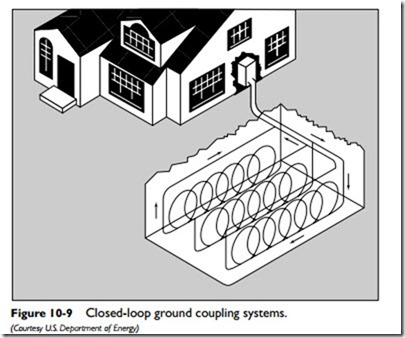Water-Source Heat Pumps
Water-source heat pumps use water for both the heat source and the heat sink. The water serves as a direct heat transfer medium in contrast to the heat transfer fluid used in closed-loop systems. The steady cool temperature of the water offsets the seasonal temperature variations by serving as a reservoir of heat in the winter and as a drain of heat in the summer. The compressor and controls of a water-source heat pump are identical to those in a ground-source heat pump.
Water-Source Coupling System
A water-source heat pump uses both the open-loop and closed loop coupling systems. The open-loop coupling system uses local groundwater from extraction wells or extraction and reinjection wells (see Figure 10-10). In some systems, a single standing column
well is used as the water source. A standing column well allows the major part of the discharge water from the heat pump to be reinjected into the source well. This method eliminates the need for a separate reinjection well.
A submerged closed-loop piping system is used with a water- source heat pump if the heat source and discharge area is a lake, pond, or stream. Using a closed-loop system avoids the problem of discharging the water back into the lake, pond, or stream, which can be an environmental concern.
The water in the pipes of a water-source closed-loop system is circulated between the source (that is, the lake, pond, or stream) and a refrigerant-to-water heat exchanger and then back to the source. The compressor pumps a refrigerant through separate coils in the refrigerant-to-water heat exchanger. The heat transfer occurs in the heat exchanger.
Advantages and Disadvantages of Water-Source Heat Pumps Installing a water-source heat pump can be a problem in many areas of the country because there are no uniform regulations governing the discharge of the water after the heat has been extracted. It could be an important environmental concern. Always check any existing federal, state, and local codes and requirements governing the installation and use of water-source heat pumps. Some of the requirements governing their use include the following:
• Local ordinances may require the water to be discharged through a sewer or a second well. The former method requires a hookup fee (which commonly includes the cost of trenching and pipe laying) and an increased monthly sewer bill. The latter method requires the expense of drilling a return well. Water discharged to a return well also may require an EPA reporting procedure.
• Return wells for discharge water must be installed by licensed drillers. The drillers must submit well logs and well locations to the Bureau of Topographic and Geologic Survey at the Department of Conservation and Natural Resources.
• Water discharged to a lake, pond, or stream may require a National Pollutant Discharge Elimination System (NPDES) permit.
• A well used as a water source must have sufficient flow and adequate temperature for the heat pump.
The principal advantage of a water-source heat pump is that water temperatures are warmer and more stable than air during the cold winter months, which makes it more efficient than the air- source heat pump. The two principal disadvantages of this type of pump are its higher installation cost and the lack of uniformity among federal, state, and local codes and regulations.
